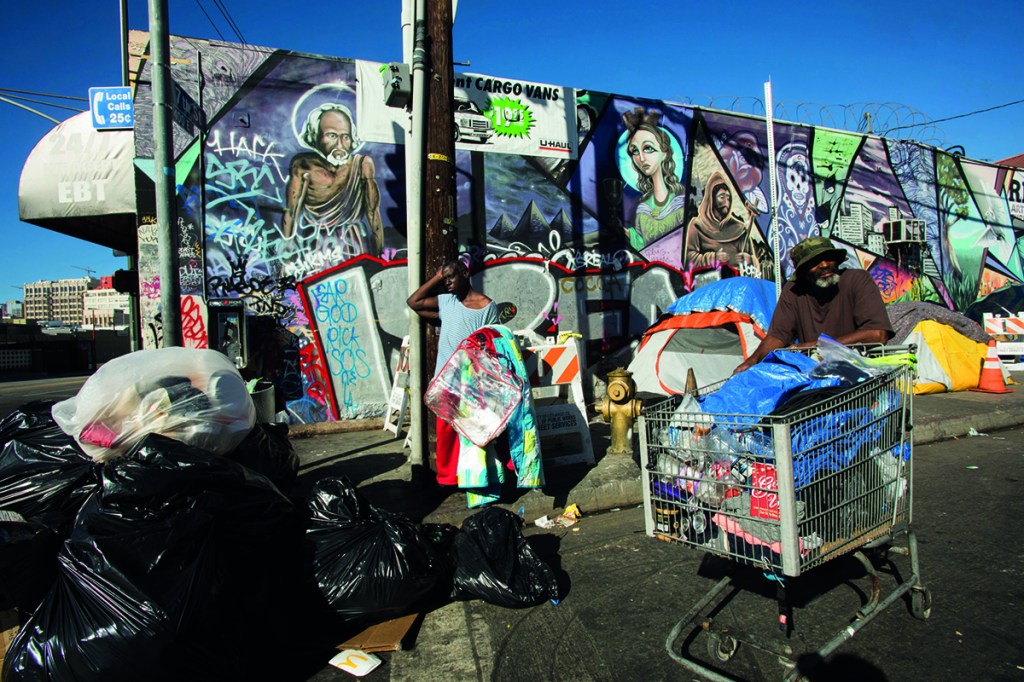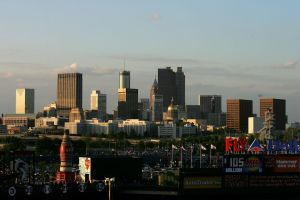It was a punch in the face, followed by a thick spray of blood. Then another punch, another victim. More blood. I was witnessing a random assault on two elderly tourists in broad daylight. A man walked up to a couple, hit the woman so hard she fell to the ground bleeding and when the husband stepped forward to protect her, he too was pummeled.
‘I saw what you did!’ I yelled as the assailant fled. I called 911 and followed him through a parking garage and onto a side street. In a few minutes, police arrived and apprehended the man. As rescue workers attended to the victims, an officer asked if I would testify in court. I agreed and watched as the attacker was handcuffed and removed.
Ever since this incident in my neighborhood in the Hollywood Hills in 2017, I’ve been stunned by watching the mayhem that permeates California. Last year there were 2,202 murders, the most in more than a decade. Rape, aggravated assault and auto thefts are also increasing.
A lot of the crime happening in California can be traced to a bill and propositions that were backed and funded by the ACLU, then-governor Jerry Brown and the billionaire hedge fund manager George Soros. The measures were given ironic names such as the California Public Safety Realignment Act, which allowed more than 30,000 criminals to be released from state prison; the Safe Neighborhoods and Schools Act, which turned all drug and theft crimes under $950 into misdemeanors (leading drug dealers and addicts to flood into California to take advantage); and the Public Safety and Rehabilitation Act, which empowered the Department of Corrections and Rehabilitation to determine which prison inmates are eligible for early release, including violent criminals and murderers who are in for life. In May, state officials announced that 76,000 inmates — or three-quarters of the entire state prison population — would be able to ‘earn their way home sooner’.
Adding to the change in the state are the more than 161,000 people — including the attacker I witnessed — who now live on California’s streets. While they don’t commit most of the crime, their offenses are treated differently because of their plight. As LA County District Attorney George Gascon has stated, if you live on the street or are addicted or have a mental disorder and commit crime, then you shouldn’t be imprisoned like someone who is housed. You’re already living on the margins and to put you behind bars would be ‘inhumane’, he says. Because of this approach, we’re confronted with post-apocalyptic scenes like something out of Mad Max every day in Los Angeles.
In recent months, there has been an uptick in attacks with machetes, hatches and axes. Along the 101, discarded mattresses, a birdcage, empty water coolers, pylons and shopping carts cover the embankments. A goat is a recent addition to the ‘encampments’ on the sidewalks and median under the Gower Street bridge in Hollywood.
Echo Park (known for the boating scene in Chinatown when private detective Jake Gittes trails Hollis Mulwray and his ‘girlfriend’) is now infamous for the 35.7 tons of waste that city sanitation workers removed from there in May, including almost 200 pounds of feces and urine, and 30 pounds of hypodermic needles. Health officials had to declare part of downtown a ‘typhus zone’; because the area was so filthy, a deputy city attorney and police officers contracted typhus and typhoid fever. In a 2018 report, the United Nations said that LA ‘failed to meet even the minimum standards the United Nations High Commissioner of Refugees sets for refugee camps in the Syrian Arab Republic and other emergency situations’. Last year, there were more than 4,240 fires in LA connected to sites where homeless people live.
Some of the most violent clashes have occurred at the beach. In July at a parking garage in Santa Monica, a couple was attacked by a transient. He tried to rape the woman, commandeered their car and ran over the man twice, putting him in the hospital. Last week in Malibu, a man terrorized a family with a machete and slashed the dad’s face, causing him to lose an eye. Turns out the assailant was first arrested in April for threatening a sheriff’s deputy. Gascon filed a misdemeanor charge against him and then released him. While authorities have moved tents from Venice Beach in recent weeks, homeless people have fanned out into the nearby streets and alleys.
‘A disgrace,’ is how Gov. Gavin Newsom described the crisis last year. In his State of the State address, he criticized ‘the richest state in the nation’ for ‘failing to properly house, heal and humanely treat so many of its own people’. LA’s mayor, Eric Garcetti, too, has spent his time in office promising to put a stop to the tens of thousands who are living on the street. ‘We can’t accept that,’ he said in 2017. ‘We won’t.’
But it is under their tenures that California has become a disaster area. Last year, a group of Angelenos sued the city in federal court for negligence, violation of a mandatory duty to keep the city safe and clean, waste of public funds, violations of state environmental laws, and other malfeasance. In response, US District Court Judge David O. Carter ordered that any funds Garcetti was planning to use for his ‘bold, progressive vision’ be placed in escrow. Carter also demanded independent investigations and audits of City Hall, where he says officials have violated state and federal laws by not addressing the crisis.
There are more than 14,000 vacant city-owned properties in Los Angeles and 1.5 million square feet in one facility alone that could be used as shelter and facilities to treat addictions and mental illness, but Newsom and Garcetti have done little except give speeches, pass money through the bureaucracy and make deals with developers for housing that never gets built. Meanwhile, Newsom blamed September 14’s gubernatorial recall vote on ‘anti-vaccine, QAnon extremists and violent white supremacists like the Proud Boys’. Garcetti has ended the daily COVID briefings that he signed off, ‘Strength and love, Los Angeles’, and is looking to his golden parachute from President Joe Biden — the position of US Ambassador to India.
When a police detective said I would be his star witness against the attacker, that was the last I heard. That was in 2017. In June, I contacted the victims and got a similar story about their desire for justice. ‘I just gave up,’ their daughter said. ‘I told my parents he’d been sentenced just to make them feel better, but he could have been walking free days later, who knows.’
This failure to follow through is familiar to Angelenos. The Nextdoor app carries testimonies of how nothing ever changes — police telling neighbors they can’t do anything about crime because the city and state have tied their hands. And whenever government officials do act, it’s ridiculous.
Tents across from Barnsdall Art Park, also in my neighborhood, turned out to be a gang-controlled drug-dealing operation. For months, the city ignored them while the drug dealers stole power from streetlights, sold narcotics to drive-up customers and fired guns at night. Officials only got involved when a tarp blocked the sidewalk — a violation of the Americans with Disabilities Act, they claimed. Rather than putting the drug dealers and gang members in jail and cleaning my neighborhood, the city of LA bought them a $1,600 streamlined tent and installed a porta-potty. ‘I’ve never encountered anything like this in my 25-year history on the force,’ LAPD officer Leo Ray told ABC 7’.
The monster who I saw attack the couple never went to jail. In fact, after inquiring with officials for weeks this summer, I learned his case was dismissed. An assistant sheriff responsible for the county jail was the one who disclosed to me that the offender was also arrested last fall for another assault — worse than the one I saw. Even though he has a felony arrest record going back two decades, a judge diverted the man’s yearlong county jail sentence to a rehab facility — under LA’s Alternative to Incarceration Initiative — from which he has escaped.
Toward the end of summer, the red LA sunset takes on an ominous tinge. Watching it of late, I’m reminded of Marshall Frady’s line about California being the climax of our destiny. ‘This is what it has all come to,’ he wrote back in 1969, ‘the place where America gets its signals of what is about to happen to it.’
John Meroney, a writer in Los Angeles, is consulting producer of The People v. The Klan, a CNN Original Series. This article was originally published in The Spectator’s October 2021 World edition.


















